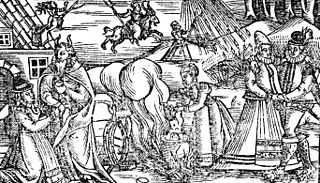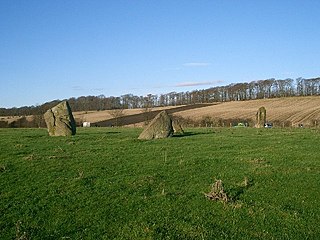Related Research Articles

Isobel Gowdie was a Scottish woman who confessed to witchcraft at Auldearn near Nairn during 1662. Scant information is available about her age or life and, although she was probably executed in line with the usual practice, it is uncertain whether this was the case or if she was allowed to return to the obscurity of her former life as a cottar’s wife. Her detailed testimony, apparently achieved without the use of violent torture, provides one of the most comprehensive insights into European witchcraft folklore at the end of the era of witch-hunts.

Torryburn is a village and parish in Fife, Scotland, lying on the north shore of the Firth of Forth. It is one of a number of old port communities on this coast and at one point served as port for Dunfermline. It lies in the Bay of Torry in south western Fife.

In early modern Scotland, in between the early 16th century and the mid-18th century, judicial proceedings concerned with the crimes of witchcraft took place as part of a series of witch trials in Early Modern Europe. In the Late Middle Ages, there were a handful of prosecutions for harm done through witchcraft, but the passing of the Witchcraft Act 1563 made witchcraft, or consulting with witches, capital crimes. The first major issue of trials under the new act were the North Berwick witch trials, beginning in 1590, in which King James VI played a major part as "victim" and investigator. He became interested in witchcraft and published a defence of witch-hunting in the Daemonologie in 1597, but he appears to have become increasingly sceptical and eventually took steps to limit prosecutions.

The great Scottish witch hunt of 1649–50 was a series of witch trials in Scotland. It is one of five major hunts identified in early modern Scotland and it probably saw the most executions in a single year.

Witchcraft in Orkney possibly has its roots in the settlement of Norsemen on the archipelago from the eighth century onwards. Until the early modern period magical powers were accepted as part of the general lifestyle, but witch-hunts began on the mainland of Scotland in about 1550, and the Scottish Witchcraft Act of 1563 made witchcraft or consultation with witches a crime punishable by death. One of the first Orcadians tried and executed for witchcraft was Allison Balfour, in 1594. Balfour, her elderly husband and two young children, were subjected to severe torture for two days to elicit a confession from her.
Beatrix Leslie was a Scottish midwife executed for witchcraft. In 1661 she was accused of causing the collapse of a coal pit through witchcraft. Little is known about her life before that, although there are reported disputes with neighbours that allude to a quarrelsome attitude.
Euphame MacCalzean was a victim of the North Berwick witch trials of 1590–1591.
Margaret Burges, also known as 'Lady Dalyell', was a Scottish businesswoman from Nether Cramond who was found guilty of witchcraft and executed in Edinburgh in 1629.
Bessie Wright was a healer in Perthshire who was accused of witchcraft in 1611, 1626 and then again in 1628.
Alison Pearson was executed for witchcraft. On being tried in 1588, she confessed to visions of a fairy court.

Lilias Adie was a Scottish woman who lived in the coastal village of Torryburn, Fife, Scotland. She was accused of practising witchcraft and fornicating with the devil but died in prison before sentence could be passed. Her intertidal grave is the only known one in Scotland of an accused witch – most were burned.

The Witches' Well is a monument to accused witches burned at the stake in Edinburgh, Scotland, and is the only one of its kind in the city.

The Survey of Scottish Witchcraft is an online database of witch trials in early modern Scotland, containing details of 3,837 accused gathered from contemporary court documents covering the period from 1563 until the repeal of the Scottish Witchcraft Act in 1736. The survey was made available online in 2003 after two years of work at the University of Edinburgh by Julian Goodare, now a professor of history at the University of Edinburgh, and Louise Yeoman, ex-curator at the National Library of Scotland, now a producer/presenter at BBC Radio Scotland, with assistance from researchers Lauren Martin and Joyce Miller, and Computing Services at the University of Edinburgh. The database is available for download from the website.

Julian Goodare is a professor of history at University of Edinburgh.
The Fife Witches Trail is a series of plaques located along the Fife Coastal Path, commemorating the women executed as witches there in the 16th to 18th centuries. The plaques are located in the villages of Culross, Valleyfield and Torryburn.
Margaret Barclay, was an accused witch put on trial in 1618, 'gently' tortured, confessed and was strangled and burned at the stake in Irvine, Scotland. Her case was written about with horror by the romantic novelist Sir Walter Scott, and in the 21st century, a campaign for a memorial in the town and for a pardon for Barclay and other accused witches was raised in the Scottish Parliament.
Witches of Scotland was a campaign for legal pardons and historic justice for the people, primarily women, convicted of witchcraft and executed in Scotland between 1563 and 1736. A formal apology was made on 8 March 2022. The aim was also to establish a national memorial for the convicted from the Scottish parliament.
Katherine Campbell was a maidservant accused of theft and witchcraft during the last major witch hunt in Scotland, the Paisley witch trials.
Anna Tait or Anne Tait, also known as 'Hononni', was accused of witchcraft in Haddington, East Lothian in 1634 and executed in 1635. Her case revolved around her feelings of grief and guilt which caused her suicidal thoughts for the murder of her first husband and the death of her beloved daughter following a botched home abortion.

Beatrix Watsone was accused of witchcraft in 1649 at Corstorphine Parish Church, Edinburgh, and died of suicide before trial.
References
- ↑ "PORTRAIT Name: Louise Yeoman CV: Witch hunter". HeraldScotland. Retrieved 4 December 2020.
- ↑ "Going on a Witch Hunt with new BBC radio podcast". Scottish Field. 22 October 2019. Retrieved 4 December 2020.
- 1 2 "Survey of Scottish Witchcraft - Louise Yeoman". www.shca.ed.ac.uk. Retrieved 4 December 2020.
- ↑ "Louise Yeoman". Luath Press. Retrieved 4 December 2020.
- ↑ "Calls for memorial to Scotland's tortured and executed witches". The Guardian. 29 October 2019. Retrieved 4 December 2020.
- ↑ "How to bury a witch". BBC News. 28 October 2014. Retrieved 4 December 2020.
- ↑ "Time Travels". BBC. Retrieved 4 December 2020.
- ↑ "Witch Hunt". BBC. Retrieved 4 December 2020.
- ↑ Dundee, University of. "Face Of 313 Year Old Witch Reconstructed : News". University of Dundee. Retrieved 4 December 2020.
- ↑ Peebles, Cheryl. "Torryburn witch Lilias Adie honoured in village of her persecution". The Courier. Retrieved 4 December 2020.
- ↑ "Louise Yeoman". scholar.google.com. Retrieved 8 January 2021.
- ↑ Yeoman, Louise (2005). Reportage Scotland : Scottish history in the voices of those who were there. Edinburgh: Luath Press. ISBN 1-84282-051-6. OCLC 63674007.